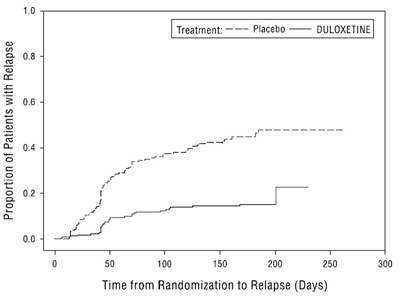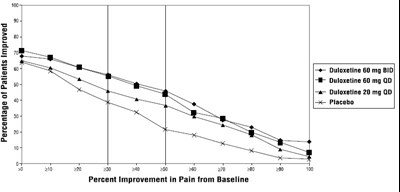Product Images Duloxetine
View Photos of Packaging, Labels & Appearance
- figure1 - duloxetine fig1
- figure10 - duloxetine fig10
- figure2 - duloxetine fig2
- figure3 - duloxetine fig3
- figure4 - duloxetine fig4
- figure5 - duloxetine fig5
- figure6 - duloxetine fig6
- figure8 - duloxetine fig8
- figure9 - duloxetine fig9
- structure - duloxetine structure
- Label Image - lbl504360198
- Label Image - lbl504360199
Product Label Images
The following 12 images provide visual information about the product associated with Duloxetine NDC 50436-0198 by Unit Dose Services, such as packaging, labeling, and the appearance of the drug itself. This resource could be helpful for medical professionals, pharmacists, and patients seeking to verify medication information and ensure they have the correct product.
figure1 - duloxetine fig1

This appears to be a graph or chart showing the number of patients with relapse over time from randomization to relapse (measured in days) for a treatment comparison between placebo and duloxetine. The graph displays data points at 100, 150, 200, and 250 days. No additional information or context is provided, so the purpose or source of the data is not clear.*
figure10 - duloxetine fig10

This text is a medicinal prescription for Duloxetine, an antidepressant medication used to treat depression, anxiety, and chronic pain. It is recommended to take Duloxetine once daily, either 60 mg or 120 mg. The rest of the text seems to be a graph showing the percentage improvement in pain from baseline after taking the medication. Therefore, this is a medication prescription along with a pain improvement graph.*
figure2 - duloxetine fig2

The text displays a graph showing the proportion of patients with a relapse over time from randomization to relapse (in days) in a study comparing the effectiveness of a placebo to a drug called Duloxetine. The y-axis ranges from 0 to 10 and is labeled with increments of 2. The x-axis ranges from 0 to 300 days and is marked at intervals of 50.*
figure3 - duloxetine fig3

The text is a table showing the percentage of patients who improved while taking Duloxetine at different doses compared to placebo. It also includes the percentage improvement in pain from baseline.*
figure5 - duloxetine fig5

The text is providing a comparison between different medications for pain management based on the percentage of patient improvement. It displays a graph that shows the percentage of improvement in pain from the baseline for three different medications: Duloxetine 60mg twice daily, Duloxetine 60mg once daily, and Placebo.*
figure8 - duloxetine fig8

This is a description of a medication called Duloxetine. The recommended dosage is 60-120 mg taken once daily. The text also mentions placebo and percent improvement in pain from baseline, but the context is unclear.*
figure9 - duloxetine fig9

This appears to be a chart or graph displaying the percent improvement in pain from baseline for a treatment involving both Placebo and Duloxetine, with the latter being administered at a dosage of 60 mg once daily. The chart is divided into increments of 10, up to 100, with accompanying numerical values. However, there is a significant amount of garbled and unreadable text, likely a result of errors or formatting issues.*
Label Image - lbl504360199

This is a description of Duloxetine Hydrochloride L, a delayed-release drug marked by "3". It comes in 30 capsules per container, and each capsule contains entrccosted pelets made by AJANTA PHARMA USA Inc. Each capsule has 160mg of duloxetine hydrochloride, equivalent to 60mg dosage. The drug should be kept in a tightly closed container at controlled room temperature, i.e., 25°C(77°F). Further dosage information can be found in the package insert. The drugs should be kept out of reach of children. The container has LOT: 30006 EXP: XXX/ and is dispensed by Uni DoseServies, LLC, Doy, FL 55004. There is a warning about keeping the drug out of reach of children, and the use of the drug is RxOnly. The information about NOC, NDC, DO TIE is not available.*
* The product label images have been analyzed using a combination of traditional computing and machine learning techniques. It should be noted that the descriptions provided may not be entirely accurate as they are experimental in nature. Use the information in this page at your own discretion and risk.



